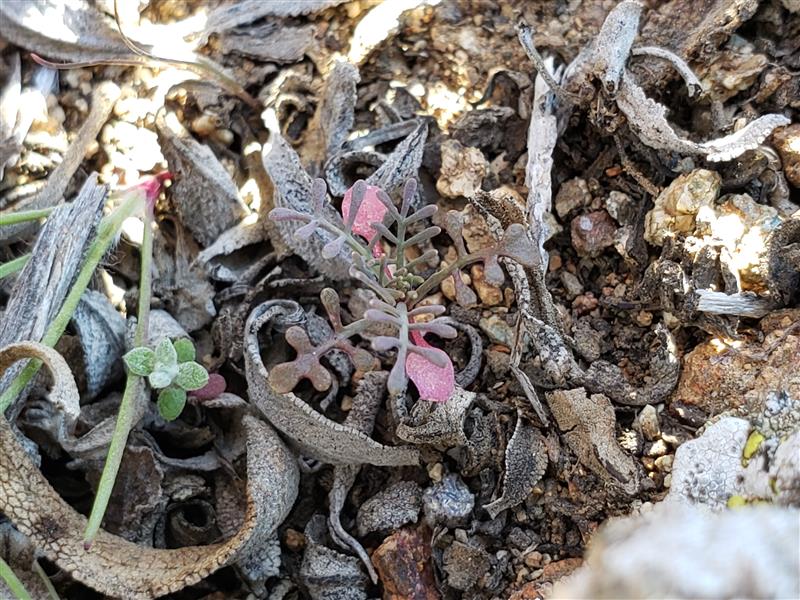Conservancy Surveys the Secretive Scripps’s Murrelet
ConservationSeabird surveys provide information on how to best protect the elusive Scripps’s murrelet.

Sourced from: The Catalina Islander – April 9, 2021
A sliver of moon provided just enough light to steer the 14-foot Zodiac as wildlife biologists navigated a section of Catalina Island’s rocky coastline.
“Two sit, one fly, one flush,” called out Darrell Whitworth of the California Institute of Environmental Studies. He was on hand, contracted by Catalina Island Conservancy, to help perform surveys of the rare Scripps’s murrelet (Synthliboramphus scrippsi), a unique little seabird listed as threatened by the State of California with a population of only 5,000-10,000 breeding pairs.
Conservancy staff marked down the data, reflecting that two of the seabirds were seen sitting, one in flight and one that just started flying when the light reached it, coupling the information with GPS data. American Conservation Experience and Catalina Island Conservancy Wildlife Intern Ricky Robbins went out for several nights of seabird spotting, sometimes joined by Conservancy Native Plant Manager Seth Kauppinen and CIC Director of Conservation Deni Porej. The spotlight survey for these seabirds was developed by Whitworth around 2000, wherein biologists scan the sea next to cliffs to count the birds.
The Island Conservancy leads around two Scripps’s murrelet surveys each year, monitoring the same transect between Two Harbors and Twin Rocks in order to gauge population. This is not an easy feat. In addition to spotting birds on the water, murrelet surveys also involve catching and banding individual birds as well as looking for nests.
“Scripps’s murrelets are very secretive and spend most of their life out on the ocean,” said Emily Hamblen, Conservancy Wildlife Biologist. “These tiny, flying, black and white birds hide from everything. Cats, foxes, rats and mice all pose a threat, whether to the murrelet itself or their eggs, so the places that they choose for their nests are very hard to find. They are on the steepest slopes, tucked deep in burrows.”
Tagging birds presents its own challenges. Nests are difficult to find, and even more difficult to get to. Birds cannot be tagged at their nests because they will abandon their chicks, so biologists use a net to catch birds sitting on the water.
“Catching them on the water is really the only thing we can do,” said Hamblen, who added that they check each bird’s chest for a brood patch–a spot where they lose their feathers so that their eggs rest directly against the skin to transfer heat more efficiently.
Once they catch a bird, biologists gather information and affix a band to its leg. Based on banding studies, Whitworth believes that Scripps’s murrelets can live to be about 20 years old, though reaching that age is likely uncommon.
“The more birds you band, the better idea you can get of how long they can live. Also, when you get a large number of them banded, you can start looking to estimate the population size based on recaptures,” said Whitworth.
Murrelets, both the Scripps’s murrelet and the Guadalupe murrelet, are spread throughout 12 or 13 islands where they breed. Though impossible to determine an exact count, biologists estimate that Catalina hosts “probably a couple hundred” nesting pairs. The 2021 surveys yielded 19 newly-banded murrelets with 640 observations over 10 surveys (with a lowest count of 33 and highest count of 126).
Due to the elusive nature of these seabirds, there are many things that biologists are still curious about.
“The murrelet’s life history makes them very difficult to study,” said Whitworth. “Surveys haven’t been going on for long enough to really see long-term trends.” However, there are some things that we can be sure of.
Scripps’s murrelets are less than 10 inches long and weigh around 6 ounces. They only come ashore for breeding purposes, otherwise living their lives entirely at sea. Females lay two eggs a time, which are incubated for a bit more than a month. Male and female birds will incubate their eggs on four-day shifts, with one heading out to feed for four days before returning and to relieve their counterpart. Once chicks have hatched, they are only in the nest for two days before braving the seas with their parents to live on the water around 50-70 miles offshore.
Eggs may not hatch because of predation or abandonment. Because nests are so difficult to locate, it is impossible to determine what percentage of eggs actually hatch, let alone how many chicks live to adulthood.
“As far as I’m concerned, some of these things we are never going to be able to figure out,” said Whitford, mentioning that things such as diet studies involve lethal capture of birds that he thinks is neither necessary nor warranted at this time. Other questions would require “a lot of money and a lot of time to approach answers. But as time goes on and these surveys continue, then we can more confidently say what the population is doing.”
Continuing studies of these inconspicuous birds is important because they face very real risks.
“Seabirds have more challenges because they rely on both ocean and land resources,” said Hamblen. “If something goes wrong in the ocean, such as not having enough food, then the population declines. If there’s development on land and their nest crevasses are filled in, or there are more rats and mice, then they are unable to successfully reproduce.”
Though you may only see them rarely, during a channel crossing or on the water, these resilient little birds have a home on Catalina Island. The more that we are able to study them and protect sensitive areas, the better the chance they have to thrive.
Learn more about Catalina Island Conservancy’s work with seabirds.

